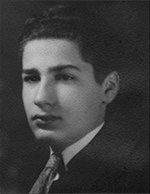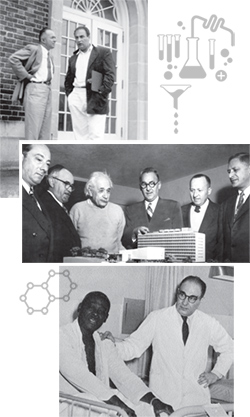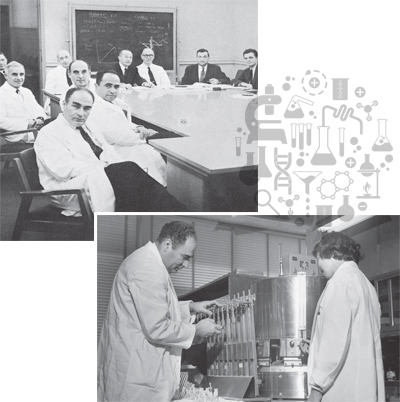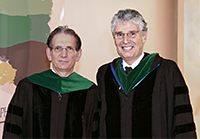Early Years
Saul Roy Korey was born on April 12, 1918, in New York
City, the elder of two sons of a physician. His younger
brother had Down's syndrome and died at the age of 3.

A young Saul KoreySaul was just 14 when he graduated from high school at
the height of the Depression. An early indication of the
compassion that would one day make him a caring physician
is reflected in his actions during that time. Noticing
that many of his high school classmates who came from
more modest circumstances were unable to get or bring
lunch with them, the young Saul Korey would make extra
sandwiches at home and bring them to school to share.
Following high school, he attended Cornell for two years;
he left after learning that, at age 16, he could be accepted
to the medical school at the University of Western Ontario,
in Canada.
Six years later, at just 22, he graduated first in his class
with the gold medal and B. T. Mughal Prize in Psychiatry.
When his parents attended the graduation, he presented
his mother with an open program and said, "Look, they left
me off the listing of graduates." Before she could get too
dismayed, he closed the program to show her the cover —
where, in honor of his class position, his photo and name
were prominently displayed.
Shortly after completing his one-year internship in 1940–
41, Korey was drafted into the Coast Guard. An injury
he sustained on board ship led to an assignment at the
Marine Hospital in New Orleans. Around the time he got
out of the hospital, he met and married Doris Broder, who
joined him in Louisiana.
Medical Career

Top: Dr. Korey (at right) with his mentor, Dr. David
Nachmansohn, at Woods Hole
Middle: Professor Einstein viewing a model of the medical institution that now bears his name
Bottom: Dr. Korey with a patientIn 1945, following his discharge from military service at
the end of World War II, Dr. Korey entered the Neurological
Institute of Columbia Presbyterian (NI) for three years of
residency training. He ultimately served as chief resident.
During this time, he wrote his first book, in collaboration with
John Nurnberger, called Pituitary Chromophobe Adenomas:
Neurology, Metabolism, Therapy.
While at NI, Dr. Korey met Dr. Irving London, a hematologist
who was completing a basic science fellowship, studying the
hemoglobin molecule. Dr. Korey followed this example; upon
completion of his own residency, he sought a three-year
research fellowship in neurochemistry, studying with Dr. David
Nachmansohn at Columbia and Dr. Severo Ochoa at New
York University. This was highly unusual at the time. Today, it
would be the equivalent of completing an M.D./Ph.D.
Following his research fellowship, Dr. Korey was recruited
to the neurology service at Case Western Reserve Medical
School, in Cleveland, where he remained until 1955.
Coming to Einstein
In 1953, Yeshiva University broke ground for
the construction of a new medical school that
would bear the name of the great physicist Albert
Einstein. It would be the first medical institution in
the United States under Jewish auspices; a fundamental
concept of the medical school — insisted
upon by Dr. Einstein — was that it would be open
to all individuals seeking medical education. At the
time, already existing medical schools had tacit
quotas concerning the acceptance of students
from various backgrounds, including Jews, blacks
and Italians.
Two years later, prior to the medical school's
opening in September 1955, Dr. London —
Einstein's first chair of medicine — invited Dr. Korey
to join him among the founding faculty members of
the College of Medicine. He recruited Dr. Korey to
head up the neurology division.
At age 37, Dr. Korey moved back to New York,
where he worked closely with Dr. London to
establish Einstein as one of the best research
medical schools. He told his friend and colleague,
"Harvard, move over!"
Creating a Legacy
As Dr. Korey set up the division of neurology, he recruited
recent graduates from the NI residency, including Labe
Scheinberg, M.D., Robert Katzman, M.D., Isabelle Rapin,
M.D., and Elliot Weitzman, M.D., as attending physicians to
run the neurology service and residency at the new Bronx
Municipal Hospital Center (now Jacobi Medical Center)—
Einstein's teaching hospital at the time. Dr. Korey fully
expected all these recruits to do research in addition to their
clinical duties.

Top: Dr. Korey (front, left) with other members of the
Einstein faculty
Bottom: Dr. Korey working in the labThe first neurology resident Dr. Korey recruited to the program
was Dr. Herbert Vaughan; he eventually went on to become
the third director of Einstein's Rose F. Kennedy Center.
To round out the core of his program, Dr. Korey sought basic
science investigators from various disciplines outside neurology
to conduct research with the division's neurologists. Among
them were young specialists in organic chemistry (William
Norton, Ph.D.); biochemistry (Robert Ledeen, Ph.D.); neurochemistry
(Kunihiko Suzuki, M.D.); neuropathology (Robert
Terry, M.D., Nicholas Gonatas, M.D., and Kinuko Suzuki,
M.D.); and neuropsychology (Louis Costa, Ph.D.). All of them
were to focus their efforts on innovative, multidisciplinary basic
research on human diseases, notably Tay-Sachs and
Alzheimer's diseases.
"They took the index of Merritt's Textbook of Neurology and
they went through it to pick promising candidates for study,"
explained Dr. Rapin. "They determined that Tay-Sachs disease
and Alzheimer's disease weren't being studied by anyone
else, so there wouldn't be competition. Also, a disease like
Tay-Sachs, a uniformly fatal genetic disorder that occurs mostly
in infants of Jewish descent, though rare, would, with the
Ashkenazi Jewish population in New York, be approachable.
"At the time there was an entire ward of about 20 children
with the disease in the Jewish Chronic Disease (now
Brookdale) Hospital, in Brooklyn. Dr. Korey met with their
parents to explain his research plan and to engage the
collaboration of a number of them, who gave him access
to their children's medical information and further studies."
"He encouraged interaction between clinicians and scientists, as well as engaging patients and their families as collaborators in the study. This is an important part of the legacy that he left us."
Dr. Solomon Moshé
In addition, Dr. Terry received the first grant supporting
Alzheimer's research ever given by the National Institutes
of Health (NIH). The team also focused on the more common
neurologic disease multiple sclerosis, taking advantage
of Dr. Norton's expertise in lipid chemistry.
In pursuing their work, Dr. Korey believed that clues from
the bedside could and should be examined at the laboratory
bench, and vice versa. "He encouraged interaction
between clinicians and scientists, as well as engaging
patients and their families as collaborators in the study,"
noted Dr. Solomon Moshé, a current Einstein faculty member.
"This is an important part of the legacy that he left us."
Long a proponent of a multidisciplinary approach to tackling
clinical puzzles, in 1957 Dr. Korey and Dr. Milton
Rosenbaum, chair of psychiatry, sought and received a
grant from the NIH to support an interdisciplinary program
geared to postdoctoral fellows in the neurosciences.
The grant also allowed Dr. Korey to invite distinguished
visiting professors to give lectures and be available for
discussions with interested fellows. In addition, it supported
research relevant to the nervous system in several
departments, as well as providing protected time for
young clinician-researchers. This grant continued for 37
years, and served as a key factor in the establishment of
Einstein's department of neuroscience.
Moving Einstein Forward
Among Dr. Korey's lasting contributions to the College
of Medicine was his role, along with Dr. London, in
convincing the dean at the time, Dr. Marcus Kogel,
and Einstein's Board of Overseers that the College of
Medicine needed a basic science research building. In
the year before his death, Dr. Korey was involved in the
details connected to the construction of the Ullmann
Research Center for Health Sciences. Unfortunately,
during the year that the building was completed, he
was diagnosed with pancreatic cancer. He died on
September 27, 1963, six months before the new building
opened. Ullmann helped expand the research
capabilities at Einstein, including providing a home for
the first liver center in the United States to receive
NIH funding.
A Devoted Staff

Dr. Korey with neurology residents and members of the neurology division, in 1960When the members of the neurology department
learned that their chair had been diagnosed with
pancreatic cancer, they had no idea that in just four
months he would succumb to the disease.
Earlier in 1963, a paper written by Albert Szent-
Györgyi, a Nobel Prize winner who worked at the
Marine Biological Laboratory, in Woods Hole, appeared
in Science. It had described a product in urine,
called retine, as a cure for cancer.
"When Saul was diagnosed with cancer, all of us who
knew about this retine idea thought that we would be
remiss if we didn't do our best to get this retine ourselves,"
recalled Dr. Bill Norton. "I drove up to Woods
Hole with Stan Samuels, warning Szent-Györgyi that
we were coming. He told us how to make this product
and how much urine it was going to take.
"When we got back, we set up a carboy with a funnel
on it in every men's room in the Forchheimer Building
and directed everyone to use it." (A carboy is a large
glass container that has a small neck at the top, which
is often used in science labs.)
Colleague Robert Ledeen noted, "People thought we
were crazy, but we were on a mission. Our goal was to
collect enough of this material so that it might be possible
to try this treatment on Saul."
"Some told us that there wouldn't be a doctor here that
would give it to Saul," added Dr. Norton. "But we were
convinced that we had to do it."
Obtaining the retine from the urine involved an arduous
process that included boiling the collected matter
down and extracting the by-product. Despite their best
efforts, "Saul died before we got any product out that
was significant," said Dr. Norton. "It was a great idea,
and it tied everybody together, but it wasn't enough."
"It's just one indication of how the department as a
whole felt about Saul, and how urgent we felt it was to
get him back if we possibly could," said Dr. Ledeen.
Honoring a Luminary
In 2012, the College of Medicine introduced a new faculty
award at commencement, the Saul R. Korey Award
for Translational Medicine and Science. The award
honors the memory of Dr. Korey and his continuing
influence at the medical school and beyond with regard
to neurology, neuroscience and translational medicine. It
recognizes a faculty member who exemplifies Dr. Korey's
philosophy of conducting collaborative research in the
laboratory that addresses questions raised through clinical
work with patients.

(From left): The first two recipients of Einstein’s Saul R. Korey Award for Translational Medicine and Science, faculty members Robert Burk, M.D. (2013) and Solomon Moshé, M.D. (2012)In its inaugural year, the award was given to Dr. Moshé,
who noted, "I was lucky to be the first recipient, and being
given it was one of the happiest moments in my life."
When Dr. Moshé received word of his honor and the date
it was to be given, he realized he had a scheduling conflict.
He was supposed to attend an NIH-sponsored workshop
on autism in Washington, DC. "I'd been working
with the organizers for a long time and now I needed to
make arrangements to leave early," he recalled. "But all
I had to say was ‘I got the Saul Korey Award. I'm going
back to get my award,' and everyone involved knew what
that meant. The legacy of Saul Korey is much broader
than our institution."
The award at Einstein is one of three honors that have
been established to honor Dr. Korey's memory. There
also is the Saul R. Korey Medical Student Essay Award,
established in 1971 and presented by the American
Academy of Neurology (AAN), and the Saul R. Korey
Lectureship, established in 1989 by former Korey collaborator
and Einstein faculty member Dr. Robert
Terry and administered by the American Association
of Neuropathologists.
The AAN award seeks to stimulate interest in the field of
neurology as an exciting and challenging profession by
offering a highly competitive award for the best essay in
experimental neurology, judged on the basis of the quality
of the scholarship and on suitability for an audience of
general neurologists.
The Korey Lectureship honors Dr. Korey's vision of an
interdisciplinary approach to the study of neurological
diseases by basic and clinical scientists that has inspired
generations of colleagues and trainees. Dr. Terry, who
generously contributed a portion of the prize funds to endow
the Korey Lectureship, has summarized the qualities
of the Korey Lecturer as "someone who has been an
active member of the association...a working neuropathologist...
responsible for diagnostic work as well as
teaching and research…The Korey Lecturer, then, is
someone who has ‘done it all' and ‘done it well.'"
Family Life

Top: Saul Korey, with his bride, Doris (née Broder)
Bottom: Saul Korey with his son, Barry, on the beach
at Woods HoleDr. Korey married Doris Broder in 1944, when he was
26. The couple had three children: Cathie, Suzanne and
Barry. Both Barry and Cathie graduated from Einstein, in
the classes of 1982 and 1987, respectively. Suzanne is a
gifted musician and educator.
Although he was initially drawn to neurology, Barry's own
calling proved to be in psychiatry. He maintained a practice
in Westchester County, and headed the borderline
inpatient unit at New York Medical College until his premature
death at age 52, on September 13, 2008, of
ocular melanoma.
Cathie ultimately attended Einstein and pursued a career
in internal medicine after first spending 10 years as
a community organizer in New York and in the Midwest.
She recalled, "One of my fondest memories as a child
was going into my father's lab with him."
The family spent every summer in Woods Hole,
Massachusetts, where the famous Marine Biological Laboratory is a renowned haven for neurologists and neuroscientists.
"All the men would spend the morning in their
labs while the women and children were at the beach," said
Cathie. "There were only men doing research there, and the
only women I recall who were part of the overall scientific
community were Drs. Isabelle Rapin, Salome Waelsch and
Berta Scharrer—all of whom were members of the Einstein
faculty. They were the only female role models in science or
medicine that I can remember encountering at that time, and
they made a huge impression on me."
She also remembered an occasion when she was about 7
years old and someone asked her what she wanted to be
when she grew up. When she replied "a nurse," her father
corrected her, saying, "‘No, you'll be a doctor.' He wanted me
to know that it was possible, even though at the time there
weren't many female doctors."
While Dr. Korey often worked until 1 a.m., using his slide rule
to work out mathematical problems in the absence of computers,
he also made time for family. Saturday afternoons meant
trips into New York City that culminated in visits at his parents'
home at 111th Street and Broadway.
"Our father was very close with his parents. He spoke with
them every day," recalled Cathie.
She added, "We weren't aware of his influence at Einstein so
much, but I do recall his compassion. He had a good friend, a
talented scientist who was hospitalized with what would ultimately
be diagnosed as schizophrenia. The friend felt isolated
because of his illness and I remember my father would have
him over to dinner and made sure to keep his friend in the
fold, involved in discussions of the field. It was very touching."
A Lasting Legacy
In just eight years, Saul Korey established a tight-knit
team of researchers and physician-scientists; many of
these individuals remained at Einstein for 20 years or
more after his death. These people carried forward the
interdisciplinary approach to examining issues identified
at the bedside and applying theories explored in
the laboratory.

Top: Dr. Mark Mehler (front, right) and attending physicians and staff with recent
graduates of the neurology residency program
Bottom: Current Einstein faculty members, John Foxe, Ph.D. and Steven Walkley, D.V.M., Ph.D., whose collaborative efforts guide Einstein’s IDDRC program.Looking around Einstein's campus today, there are many
things that would surprise Saul Korey. Some, such as
the state-of-the-art Michael F. Price Center for Genetic
and Translational Medicine/Harold and Muriel Block
Research Pavilion, would surely delight him. The design
of that building, added to the Jack and Pearl Resnick
Campus in 2008—45 years after his death—reinforces
the multidisciplinary approach to research that he encouraged
long before the term "translational medicine"
was coined.
The interdisciplinary grant that he received in 1957,
which continued for 37 years, may also one day return,
thanks to the efforts of Drs. Steven Walkley
and John Foxe. The duo plans to submit a similar
grant for Einstein's Rose F. Kennedy Intellectual and
Developmental Disabilities Center (IDDRC) to provide interdisciplinary
training for grad students and postdocs, as
well as to seek other possible funding.
"Korey was a pioneer in his time, and created the model of interdisciplinary scholarship that has been the cornerstone of our institution since its inception"
Dr. Mark Mehler
"When we wrote the successful grant application for the
Rose F. Kennedy IDDRC program, which was awarded
funding in 2011, John and I discussed the idea of having
a training program that would allow graduate students
and postdocs to do work—basic science work—on intellectual
disability and, at the same time, have close interactions
with physicians and patients in the clinic," said
Dr. Walkley. "In conceptualizing such a program, I recalled
my experience as a young faculty member here at Einstein, when there were these ID fellows doing work in
the Kennedy Center across disciplines. I learned that ‘ID'
stood for ‘interdisciplinary,' and that these ID fellows had
been funded by a grant that Saul Korey had proposed to
the National Institute of Mental Health."
He continued, "So it's really that model that we would
like to resurrect now as part of the renaissance of the
Kennedy Center. We want to have ID fellows, postdoc
fellows and grad students working in basic science labs
but really also working with clinicians, or in some cases
clinicians working in basic science labs, where particular
diseases involving intellectual disabilities in children are
the primary focus."
"Many people who were trained by Saul went and
changed the face of neurology," noted Dr. Moshé.
"Working in the department of Saul Korey, you immediately
realize the immense ability that collaborations bring
out. Because of the people he recruited, and the way he
made us think, we developed the idea of a physicianscientist
from day one."
He added, "So, after Saul Korey, there were Bob
Katzman, Bob Terry, Bill Norton, Bob Ledeen, the
Suzukis, Isabelle Rapin, Labe Scheinberg, Herb
Vaughan, Stan Samuels, Herman Buschke, Herb
Schaumburg, Cedric Raine and many more. And now,
there are me, Mark Mehler and Steve Walkley, Robbie
Burk, Bernice Morrow and many others. And we keep
increasing the number of people who are emulating
Saul's work."
"Korey was a pioneer in his time, and created the model
of interdisciplinary scholarship that has been the cornerstone
of our institution since its inception," said Dr. Mark
Mehler, current chair of the department that now bears
Dr. Korey's name.
"In spite of his passing at the young age of 45, just eight
years into Einstein's establishment, Saul Korey remains
an integral part of our College of Medicine, its culture and
its reputation as a leading research, clinical and teaching
institution. With his spirit of creativity and humanism,
he embodied our current motto, ‘Science at the heart of
medicine.' That essence is part of his enduring legacy
at Einstein."